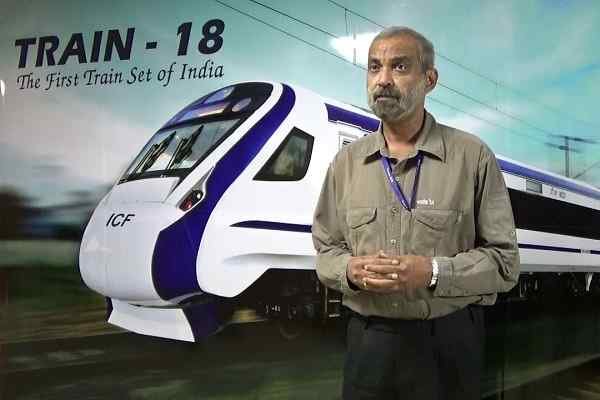The man behind Vande Bharat Express


Early in the winter of 2016, Sudhanshu Mani, who had 25 months remaining on his contract with the Indian Railways, made the decision to materialize a long-held desire. The Vande Bharat Express, also known as Train 18, began its commercial run a fortnight ago. Mani, the general manager of Integral Coach Factory in Chennai at the time, ordered his employees to start working on it.
Why do our trains always have the same appearance? Exactly the same metallic container with blank windows and doors? The author of India’s first semi-high-speed train set Train-18 Vande Bharat Express and the former general manager of the largest coach manufacturer for Indian Railways, Integral Coach Factory (ICF), Sudhanshu Mani, answers this most frequent query from commuters in his book titled, My train story 18.
In his published book, Mani describes his efforts to overcome the “babudom” barrier in order to construct and commission India’s first-ever semi-high-speed train set. Mani claimed that the thick layers of bureaucracy had attempted to thwart him at every turn since the first day and that the only reason he had been successful was because of the tenacity of his team at the ICF, with the backing of the chairman of the Railway Board and the railway minister.
Under Mani’s direction, the ICF conceptualized, constructed, and developed a 16-coach train set in 2018 that was intended for a test speed of 180 km/h and an operating speed of 160 kmph. Compared to the industry usual of roughly three to four years, the project was finished in a record-breaking time of about 18 months. The train cost R97 crore, or about one-third of what it would have cost to import one, from the drawing board to its finished physical form moving down a track. The Vande Bharat Express, first known as Train 18 and later renamed, was an instant hit and came to symbolize the inherently inventive spirit of a new India. On February 15, 2019, Prime Minister Narendra Modi signaled the start of the race.
He questioned, “Over the years in the Indian Railway trains, the only thing which changed has been the color [from gulf red to blue]. The introduction of air-conditioned coaches was a minor mutation, but that happened 40 years ago, and these AC coaches have absolutely the same recall. So why does a large 170-year-old organization with thousands of lookalike trains keep churning out more similar-looking ones?”.
Mani claims that Indian Railways has a rich history and legacy that dates back over 200 years, however, he adds, “My book is not about this legacy. It is about my despair and anguish. I have for you in this book, the story of the making of Train 18. This was the first time that our country got a fully homegrown modern rolling stock, i.e., a railway vehicle for which the concept to design engineering to manufacture to validation, and testing was done entirely in India at ICF Chennai. This is not a story of one man alone, it is the story of a dedicated team of Indians telling you that we, in India, can also do it.”
Mani describes how, when other board members urged importing it, he had to break the ice and ask the late AK Mittal, the chairman of the railway board at the time, for permission to make just two of these trains at the facility. “I begged. “Sir, you are the Chairman; nobody can restrain you.” You claim ICF can handle it. Let the board import anything they want; just give me approval for two trains, and I’ll make it at a cost that’s a third of what it would cost to import. And now, sir, unless you give me this okay, I’m going to grasp hold of your feet and not let go.
Due to the Indian Railways’ bureaucracy’s traditional mindset, all of this persuasion was necessary. Coaches are maintained in one wing, and locomotives in the other. Who would do it with a train set that was neither a carriage nor a locomotive? Who’d be the train’s owner?
He beamed, “But after hard work and determination, we could turn out the best possible product and today everyone is proud of it. We faced troubles and vigilance inquiries and are still facing problems, but we showed the world that India could manufacture the best.”
Indian Railways has now planned to acquire 44 sets of Train 18 by 2022, but there are signs that the project would be delayed well into 2024. After first almost abandoning it, which caused delays and a plethora of technical studies, the project was almost abandoned in the first place.
DISCLAIMER: The author is solely responsible for the views expressed in this article. The author carries the responsibility for citing and/or licensing of images utilized within the text.
